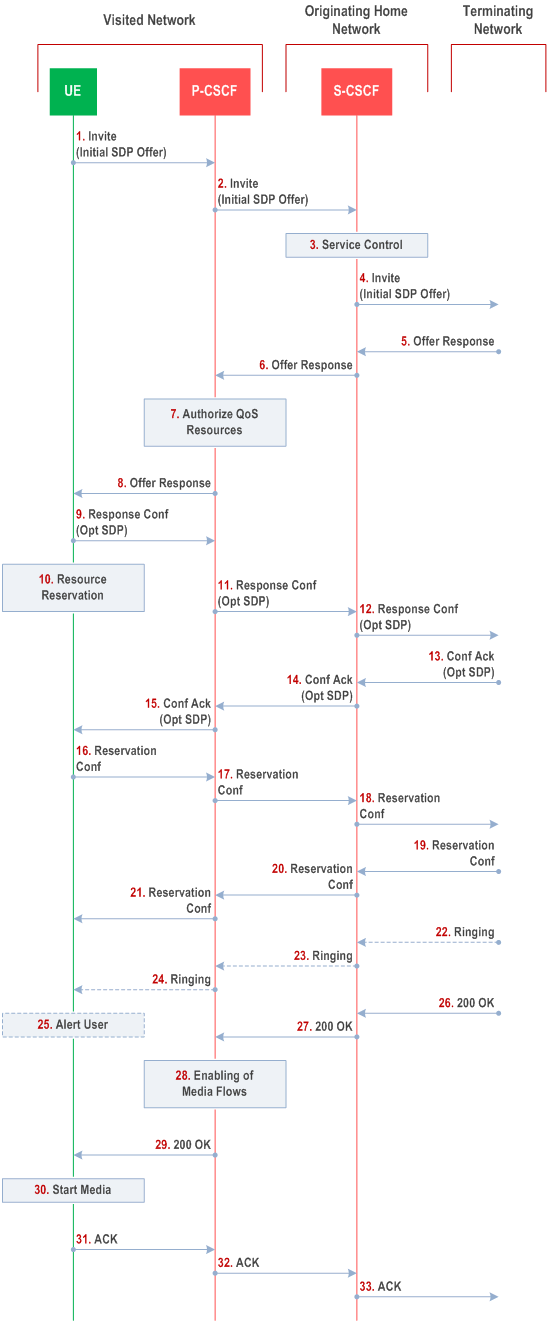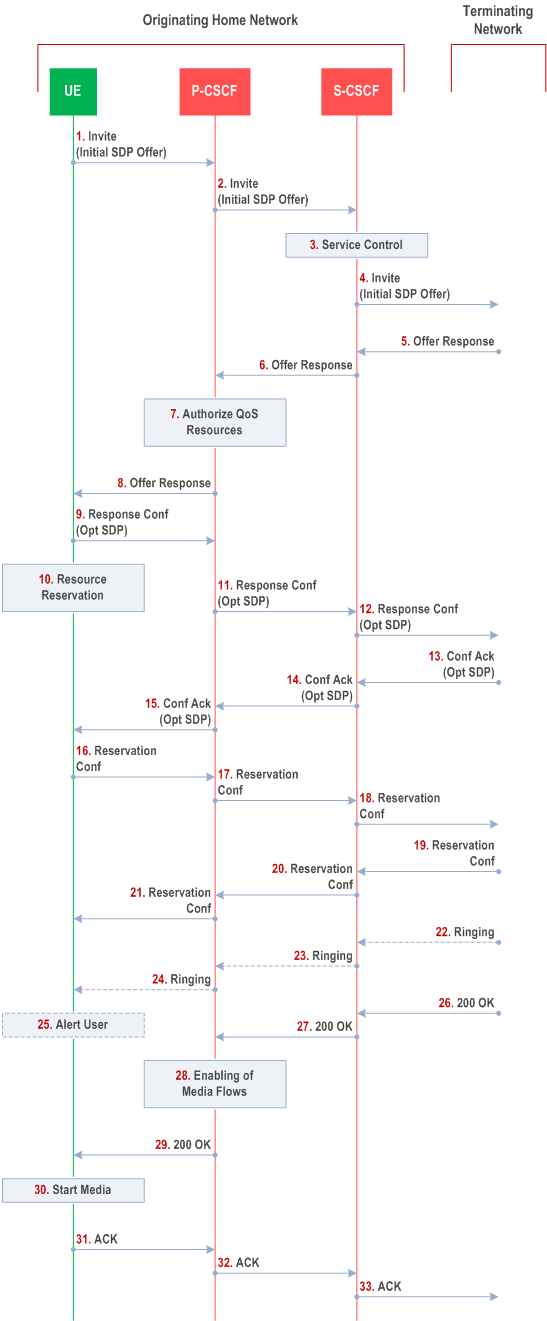Content for TS 23.228 Word version: 18.6.0
1…
3…
4…
4.2.4…
4.3…
4.4…
4.13…
4.16…
5…
5.2…
5.3…
5.4…
5.4.7…
5.4.8…
5.4a…
5.5…
5.5.3…
5.6…
5.6.3…
5.7…
5.7.3…
5.7.5…
5.7.8…
5.8…
5.10…
5.11…
5.11.3…
5.11.3.3
5.11.3.4
5.11.4…
5.11.5…
5.11.5.3…
5.11.6…
5.12…
5.16…
5.16.2…
5.19…
5.20…
A…
E…
E.2.2…
G…
G.5…
H
I…
J…
K…
L…
M…
M.3…
N…
P…
Q…
Q.2.5…
R…
S…
T…
U…
U.2…
V…
W…
X…
Y…
Z…
AA…
AA.3…
AB…
AC…
AC.7…
AC.7.2…
AC.7.2.2
AC.7.2.3…
AC.7.4…
AC.9…
5.6 Origination procedures
5.6.0 General
5.6.1 (MO#1) Mobile origination, roaming
5.6.2 (MO#2) Mobile origination, home
...
...
5.6 Origination procedures p. 118
5.6.0 General |R6| p. 118
This clause presents the detailed application level flows to define the Procedures for session originations.
The flows presented in the clause assume the use of Policy and Charging Control for the establishment of QoS-Assured Sessions.
The session origination procedures specify the signalling path between the UE initiating a session setup attempt and the Serving-CSCF that is assigned to perform the session origination service. This signalling path is determined at the time of UE registration, and remains fixed for the life of the registration.
A UE always has a proxy (P-CSCF) associated with it. This P-CSCF performs resource authorization, and may have additional functions in handling of emergency and priority sessions. The P-CSCF is determined by the CSCF discovery process, described in clause 5.1.1 (Local CSCF Discovery).
As a result of the registration procedure, the P-CSCF determines the next hop toward the Serving-CSCF. This next hop is to the S-CSCF in the home network (MO#1). These next-hop addresses could be IP addresses, or could be names that are translated via DNS to an IP address.
Sessions originated in the PSTN to a destination in an IMS network are a special case of the Origination procedures. The MGCF uses H.248 [18] to control a Media Gateway, and communicates with the SS7 network. The MGCF initiates the SIP request, and subsequent nodes consider the signalling as if it came from a S-CSCF.
5.6.1 (MO#1) Mobile origination, roaming p. 118
This origination procedure applies to roaming users.
The UE is located in a visited network, and determines the P-CSCF via the CSCF discovery procedure described in clause 5.1.1. The home network advertises the S-CSCF as the entry point from the visited network.
When registration is complete, P-CSCF knows the name/address of the next hop in the signalling path toward the serving-CSCF.

Procedure MO#1 is as follows:
Step 1.
UE sends the SIP INVITE request, containing an initial SDP, to the P-CSCF determined via the CSCF discovery mechanism. The initial SDP may represent one or more media for a multi-media session.
Step 2.
P-CSCF remembers (from the registration procedure) the next hop CSCF for this UE.
This next hop is either the S-CSCF that is serving the visiting UE.
P-CSCF determines whether the INVITE message requires priority handling based on user profile stored during the registration procedure and/or the priority requested by the user and/or MPS code/identifier included in the INVITE message. If the session is determined to require priority handling, then P-CSCF inserts/replaces the priority indication and forwards the INVITE to the S-CSCF.
Step 3.
S-CSCF validates the service profile, if a GRUU is received as the contact, ensures that the Public User Identity of the served user in the request and the Public User Identity associated with the GRUU belongs to the same service profile, and invokes any origination service logic required for this user. This includes authorization of the requested SDP based on the user's subscription for multi-media services. If the Request-URI contains the SIP URI representation of an E.164 address then the procedure specified in clause 4.3.5.3 applies.
Step 4.
S-CSCF forwards the request, as specified by the S-S procedures. When the INVITE message includes priority indication, the S-CSCF forwards the INVITE, including the Service User's priority level if available.
Step 5.
The media stream capabilities of the destination are returned along the signalling path, per the S-S procedures.
Step 6.
S-CSCF forwards the Offer Response message to P-CSCF.
Step 7.
P-CSCF instructs the PCRF/PCF to authorize the resources necessary for this session.
Step 8.
P-CSCF forwards the Offer Response message to the originating endpoint
Step 9.
UE decides the offered set of media streams for this session, confirms receipt of the Offer Response and sends the Response Confirmation to the P-CSCF. The Response Confirmation may also contain SDP. This may be the same SDP as in the Offer Response received in Step 8 or a subset. If new media are defined by this SDP, a new authorization (as in Step 7) will be done following Step 14. The originating UE is free to continue to offer new media on this operation or on subsequent exchanges using the Update method. Each offer/answer exchange will cause the P-CSCF to instruct the PCRF/PCF to repeat the Authorization step (Step 7) again.
Step 10.
Depending on the bearer establishment mode selected for the IP-CAN session, resource reservation shall be initiated either by the UE or by the IP-CAN itself. The UE initiates the reservation procedures for the resources needed for this session after determining the needed resources in step 8 as shown in Figure 5.14. Otherwise, the IP-CAN initiates the reservation of required resources after step 7.
Step 11.
P-CSCF forwards the Response Confirmation to S-CSCF.
Step 12.
S-CSCF forwards this message to the terminating endpoint, as per the S-S procedure.
Step 13-15.
The terminating end point responds to the originating end with an acknowledgement. If Optional SDP is contained in the Response Confirmation, the Confirmation Acknowledge will also contain an SDP response. If the SDP has changed, the P-CSCF validates that the resources are allowed to be used.
Step 16-18.
When the resource reservation is completed, UE sends the successful Resource Reservation message to the terminating endpoint, via the signalling path established by the INVITE message. The message is sent first to P-CSCF.
Step 19-21.
The terminating end point responds to the originating end when successful resource reservation has occurred. If the SDP has changed, the P-CSCF authorizes that the resources are allowed to be used.
Step 22-24.
Terminating end point may generate ringing and it is then forwarded via the session path to the UE.
Step 25.
UE indicates to the originating user that the destination is ringing
Step 26.
When the destination party answers, the terminating endpoint sends a SIP 200-OK final response, as specified by the termination procedures and the S-S procedures, to S-CSCF.
Step 27.
S-CSCF sends a SIP 200-OK final response along the signalling path back to P-CSCF.
Step 28.
P-CSCF indicates that the media flows authorized for this session should now be enabled.
Step 29.
P-CSCF sends a SIP 200-OK final response to the session originator
Step 30.
UE starts the media flow(s) for this session
Step 31-33.
UE responds to the 200 OK with a SIP ACK message sent along the signalling path.
5.6.2 (MO#2) Mobile origination, home p. 121
This origination procedure applies to users located in their home service area.
The UE is located in the home network, and determines the P-CSCF via the CSCF discovery procedure described in clause 5.1.1. During registration, the home network allocates an S-CSCF in the home network.
When registration is complete, P-CSCF knows the name/address of S-CSCF.

Procedure MO#2 is as follows:
Step 1.
UE#1 sends the SIP INVITE request, containing an initial SDP, to the P-CSCF determined via the CSCF discovery mechanism. The initial SDP may represent one or more media for a multi-media session.
Step 2.
P-CSCF remembers (from the registration procedure) the next hop CSCF for this UE. In this case it forwards the INVITE to the S-CSCF in the home network.
P-CSCF determines whether the INVITE message requires priority handling based on user profile stored during the registration procedure and/or the priority requested by the user and/or MPS code/identifier included in the INVITE message. If the session is determined to require priority handling, then P-CSCF inserts/replaces the priority indication and forwards the INVITE to the S-CSCF.
Step 3.
S-CSCF validates the service profile, if a GRUU is received as the contact, ensures that the Public User Identity of the served user in the request and the Public User Identity associated with the GRUU belong to the same service profile, and invokes any origination service logic required for this user. This includes authorization of the requested SDP based on the user's subscription for multi-media services. If the Request-URI contains the SIP representation of an E.164 address then the procedure specified in clause 4.3.5.3 applies.
Step 4.
S-CSCF forwards the request, as specified by the S-S procedures. When the INVITE message includes priority indication, the S-CSCF forwards the INVITE, including the Service User's priority level if available.
Step 5.
The media stream capabilities of the destination are returned along the signalling path, per the S-S procedures.
Step 6.
S-CSCF forwards the Offer Response message to P-CSCF
Step 7.
P-CSCF instructs the PCRF/PCF to authorize the resources necessary for this session.
Step 8.
P-CSCF forwards the Offer Response message to the originating endpoint.
Step 9.
UE decides the offered set of media streams for this session, confirms receipt of the Offer Response and sends the Response Confirmation to P-CSCF. The Response Confirmation may also contain SDP. This may be the same SDP as in the Offer Response received in Step 8 or a subset. If new media are defined by this SDP, a new authorization (as in Step 7) will be done following Step 14. The originating UE is free to continue to offer new media on this operation or on subsequent exchanges using the Update method. Each offer/answer exchange will cause the P-CSCF to repeat the Step 7 again.
Step 10.
Depending on the bearer establishment mode selected for the IP-CAN session, resource reservation shall be initiated either by the UE or by the IP-CAN itself. The UE initiates resource reservation procedures for the offered media as shown in Figure 5.15. Otherwise, the IP-CAN initiates the reservation of required resources after step 7.
Step 11.
P-CSCF forwards this message to S-CSCF
Step 12.
S-CSCF forwards this message to the terminating endpoint, as per the S-S procedure.
Step 13-14.
The terminating end point responds to the originating end with an acknowledgement. If Optional SDP is contained in the Response Confirmation, the Confirmation Acknowledge will also contain an SDP response. If the SDP has changed, the PCSCF authorizes the media.
Step 15.
PCSCF forwards the answered media towards the UE.
Step 16-18.
When the resource reservation is completed, UE sends the successful Resource Reservation message to the terminating endpoint, via the signalling path established by the INVITE message. The message is sent first to P-CSCF.
Step 19-21.
The terminating end point responds to the originating end when successful resource reservation has occurred. If the SDP has changed, the P-CSCF again authorizes that the resources are allowed to be used.
Step 22-24.
The destination UE may optionally perform alerting. If so, it signals this to the originating party by a provisional response indicating Ringing. This message is sent to S-CSCF per the S-S procedure. It is sent from there toward the originating end along the signalling path.
Step 25.
UE indicates to the originating user that the destination is ringing.
Step 26-27.
When the destination party answers, the terminating endpoint sends a SIP 200-OK final response along the signalling path to the originating end, as specified by the termination procedures and the S-S procedures, to S-CSCF.
Step 28.
P-CSCF indicates that the media flows authorized for this session should now be enabled.
Step 29.
P-CSCF passes the 200-OK response back to UE
Step 30.
UE starts the media flow(s) for this session.
Step 31-33.
UE responds to the 200 OK with an ACK message which is sent to P-CSCF and passed along the signalling path to the terminating end.